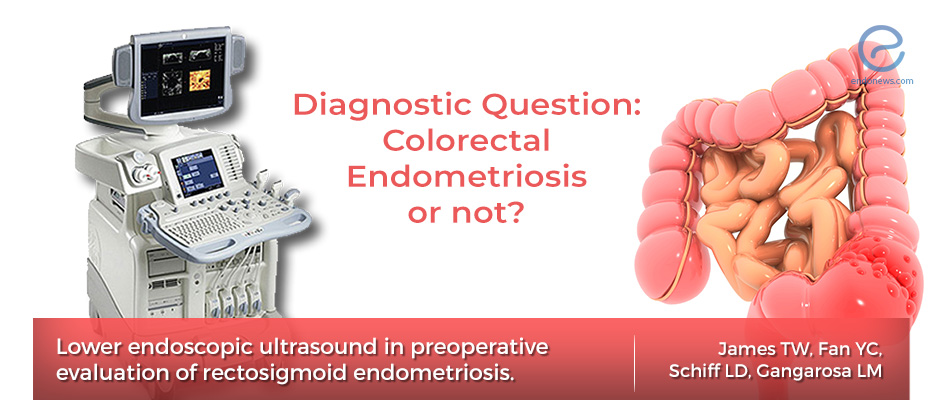The accuracy of "lower endoscopic ultrasound" for the preoperative diagnosis of rectosigmoid endometriosis
Aug 19, 2019
Rectosigmoid endometriosis can be diagnosed preoperatively with lower endoscopic ultrasound as a reliable, cost-effective and minimally invasive imaging modality.
Key Points
Highlights:
- Lower endoscopic ultrasound (LEUS) is a useful diagnostic test for preoperative evaluation in women undergoing surgery for suspected or known rectosigmoid endometriosis.
Importance:
- The preoperative evaluation of rectosigmoid endometriosis using lower endoscopic ultrasound provides optimal operative planning including appropriate equipment and staff.
What’s done here?
- This single-center retrospective cohort study was conducted at a tertiary referral center.
- Women above 18 years of age who will undergo an operation for suspected or known rectosigmoid endometriosis between 2003-2017 were included.
- All participants were assessed with lower endoscopic ultrasound under moderate or deep sedation under the supervision of one or two experienced sonographers.
- The demographic and clinical characteristics, symptoms, physical examination findings, prior imaging and endoscopic data, LEUS findings, surgical, histologic findings, and interventions recorded.
- Women who met the inclusion criteria were evaluated in two parts: the first one was the comparison of LEUS and laparoscopic findings, the second one was the comparison of LEUS and histologic findings.
- Endometrial implant located on the rectosigmoid region was defined as a hypoechoic or heterogeneous intramural lesion, usually irregularly shaped and within the bowel wall.
Key results:
- A total of 71 patients with a mean age of 34.0±6.3 years were included in the study.
- 57 patients (80.3%) had a prior diagnosis of endometriosis, and 53 patients (74.6%) underwent an operation for endometriosis.
- The most common symptom was dyschezia in women having lower gastrointestinal symptoms.
- Intraoperative histologic specimens were collected in 63 patients (88.7%) during surgery and in 17 patients during biopsy of suspected endometrial implants on the rectosigmoid location.
- The diagnosis of rectosigmoid endometriosis was confirmed histologically in 14 of these 17 patients (82.4%).
- The rectosigmoid endometriosis was diagnosed preoperatively using with LEUS in 16 patients (22.5%), the diagnosis was confirmed laparoscopically in 14/16 patients.
- The sensitivity of LEUS was 93.3%, the specificity was 96.4%, the positive predictive value was 87.5%, and the negative predictive value was 98.2%.
Limitations
- The study was conducted in a single-center.
- Only women underwent laparoscopic surgery were included, which can result in a selection-bias and overestimate the positive predictive value of LEUS.
Lay Summary
Endometriosis affects reproductive-aged women most frequently with a prevalence of 5% to 15%. If the endometriotic lesions involve the bowel especially sigmoid colon and rectum, this subtype of endometriosis is named as "bowel" or "rectosigmoid" endometriosis. Rectosigmoid endometriosis is encountered in 3.8% to 37% of all women with endometriosis.
Dyschezia, constipation, diarrhea, abdominal bloating, and cyclical rectal bleeding are the most common findings in women with rectosigmoid endometriosis.
The differential diagnosis of rectosigmoid endometriosis from irritable bowel syndrome with similar symptoms is important. Lower endoscopic ultrasound is a diagnostic test which has been used since the late 1990s and is important for surgical planning.
James et al, a group of scientists from the United States, published a study titled as “Lower endoscopic ultrasound in preoperative evaluation of rectosigmoid endometriosis” in the journal named as Endoscopy International Open. The authors aimed to evaluate the utility of LEUS in the diagnosis of rectosigmoid endometriosis, to demonstrate the diagnostic power of this test including sensitivity, specificity, positive predictive values, negative predictive values, and to assess the impact of LEUS findings on operative planning.
The women who underwent rectosigmoid surgery were evaluated by LEUS preoperatively at this tertiary referral center between 2003 and 2017 were included.
The authors found that the sensitivity of LEUS was 93.3%, the specificity was 96.4%, the positive predictive value was 87.5%, and the negative predictive value was 98.2% compared to the operative findings.
Although there are some limitations, the authors concluded that LEUS can be used as a reliable and cost-effective diagnostic tool for the diagnosis of rectosigmoid endometriosis with a favorable side effect side-effect profile. The preoperative use of this minimally invasive method is important for accurate surgical planning with appropriate equipment and staff.
“LEUS is a reliable, minimally invasive imaging modality for evaluation of rectosigmoid endometriosis with high PPV and NPV.” they added.
Research Source: https://www.ncbi.nlm.nih.gov/pubmed/31198849
endometriosis rectosigmoid endometriosis lower endoscopic ultrasound preoperative planning positive predictive value negative predictive value

